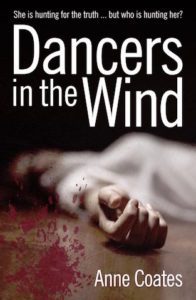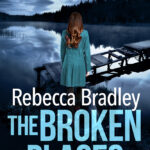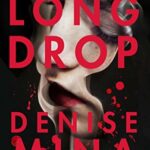I’m pleased to welcome Anne Coates to the blog to talk about her Revisions process with us today.
 Anne has written extensively for magazines and newspapers and has published seven non-fictions books and two collections of short stories. Her début crime novel Dancers in the Wind was published by Urbane Publications in October 2017. The sequel, Death’s Silent Judgement, will be out on 11 May, 2017 and can be pre-ordered from Amazon.
Anne has written extensively for magazines and newspapers and has published seven non-fictions books and two collections of short stories. Her début crime novel Dancers in the Wind was published by Urbane Publications in October 2017. The sequel, Death’s Silent Judgement, will be out on 11 May, 2017 and can be pre-ordered from Amazon.You can find Anne’s First Drafts post Here.
Your first draft has been completed, what state is it generally in?
Definitely not for public viewing, that’s for sure! I write in scenes and very often out of sequence plus there are lots of notes to myself in red like “expand this”, “check facts”, “character name?” typed all over the manuscript. The first draft is really getting words on the page and some sort of storyline before the real work takes place during the revision processes (note the plural).
What is the first thing do before you start to revise?
The most important aspect for me is to print the first draft. While writing Death’s Silent Judgement, I didn’t give the chapters numbers but always had a page break. So after printing I paper-clipped each chapter so it could be easily moved around. Then I read it through, making notes at the beginning of each chapter.
How do you assess the damage that needs working on?
It’s usually obvious where the work needs to be done. Some chapters will work really well and you get that buzz when you read them – others make my heart sink.
Do you allow anyone to read that very first draft before revisions or can you assess it objectively yourself?
Nobody would want to read my first draft! However, I had to make sure the first chapter of DSJ was “ready to go” as it is included at the end of Dancers in the Wind. I showed it to my daughter, Olivia, who made a valid point, questioning why something had happened in that way. That gave me the idea for another scene, which explained the situation.
What do you initially focus on, when approaching the completed first draft of the manuscript?
The narrative timeline. In Dancers in the Wind, the timeline is fairly linear but in the sequel there are flashbacks and letters which needed to be in exactly the right place in the story. A couple of times in the first draft I was way out of synch.
Do you have any rituals, writing or real-world, when revising a manuscript?
Can’t think of any – I walk around a lot when I’m reading out aloud and I sometimes act out scenes – playing all the parts, of course.
In what format do you revise, paper or computer?
Always revise on a print out and write suggestions or aide-memoires to myself in notebooks. However if I hit a chapter that needs a huge amount of new writing, I do that on my laptop.
Once all the revisions are complete and added to the latest word file, I print out and read again.
How messy is the revision process – can you go in and repair areas or does the whole manuscript get decimated?
Very messy and in spite of all my good intentions with paper clips, chapters do go missing in the pile of paper and I have to check back to the first draft to find page numbers to trace them.
Is revision an overhaul of the story or is it minor editing?
It’s a total overhaul. As I said, I often write chapters out of sequence so making sure the timeline is right is imperative. I also check character descriptions (especially as DSJ is a sequel) ages and ageing, and, of course, completing all the instructions or calls to action I’d left in red in the draft.
What’s the biggest change you’ve made to a story during this process?
With Dancers in the Wind, I changed the penultimate chapter just when I thought I’d finished. Suddenly it seemed far too tame so I added some drama! In Death’s Silent Judgement I cut a couple of chapters that I really liked but they didn’t sit properly in the overall narrative structure.
When first drafting, many writers keep track of progress by counting words in a day. How do you make sure you’re progressing as you’re revising?
While revising, for a change of working pace, I transfer corrections and additions to the word file and that gives me both a sense of achievement and an idea of how much more I have to do.
Do you prefer to write the first draft or do you prefer the revision process?
Although I love thinking about a new novel and contemplating characters and plots, I sometimes get bogged down in the actual writing of the first draft. However that is the stage where my characters surprise me and take me off on a different route, which is exciting. As someone who also works as an editor, I love that process plus rewriting and seeing the true shape of the book emerge.
What do you drink while you’re working?
Champagne naturally! I don’t like tea but as an insomniac I try to limit my coffee consumption to the morning and drink Yogi licorice tea in the afternoon (it’s actually more palatable than it sounds). I also drink masses of water plus the odd glass of wine to keep me going in the evening.
How long does this process take and what shape is the book now in?
For Death’s Silent Judgement all the revisions and rewriting was done over a seven-week period. During that time I was sending the manuscript in sections to two beta readers: one who’d read Dancers in the Wind and one who hadn’t to see if it stood up as a stand-alone.
By the time I submitted it to Matthew Smith at Urbane Publishing, a few days before the deadline, I thought it was in a good shape although like any writer, I kept wanting to go on tweaking! Matthew hasn’t asked for any changes so it must have passed his test.
Thanks for digging into the revisions process for us, Anne.
You can find Anne at the following places; Twitter | her Website | Amazon
Dancers In The Wind
 Freelance journalist and single mother Hannah Webridge is commissioned by a national newspaper to write an investigative article on the notorious red light district in Kings Cross. There she meets prostitute Princess, and police inspector in the vice squad, Tom Jordan. When Princess later arrives on her doorstep beaten up so badly she is barely recognizable, Hannah has to make some tough decisions and is drawn ever deeper into the world of deceit and violence. Three sex workers are murdered, their deaths covered up in a media blackout, and Hannah herself is under threat. As she comes to realize that the taste for vice reaches into the higher echelons of the great and the good, Hannah must expose the truth—and stay alive.
Freelance journalist and single mother Hannah Webridge is commissioned by a national newspaper to write an investigative article on the notorious red light district in Kings Cross. There she meets prostitute Princess, and police inspector in the vice squad, Tom Jordan. When Princess later arrives on her doorstep beaten up so badly she is barely recognizable, Hannah has to make some tough decisions and is drawn ever deeper into the world of deceit and violence. Three sex workers are murdered, their deaths covered up in a media blackout, and Hannah herself is under threat. As she comes to realize that the taste for vice reaches into the higher echelons of the great and the good, Hannah must expose the truth—and stay alive.



Great interview guys. It’s really interesting to see how different writers revise their work. Being able to write scenes out of order is not something my brain can cope with, but it is a valuable skill, so hat’s off to you Anne!
It’s so helpful and interesting to learn about how others go about the revision process. And I know what you mean about needing to completely overhaul a story. Wishing you much success! Thanks, both
Lots of water is better for you.
I always print out my manuscripts to edit. Hard to catch stuff on the screen.
“What do you drink when you’re not writing”–what a great question.
Reading (and acting) out loud works wonders to get the syntax correct. Unfortunately, when I do that in my living room, I’m in full view of all the people passing by outside 🙂